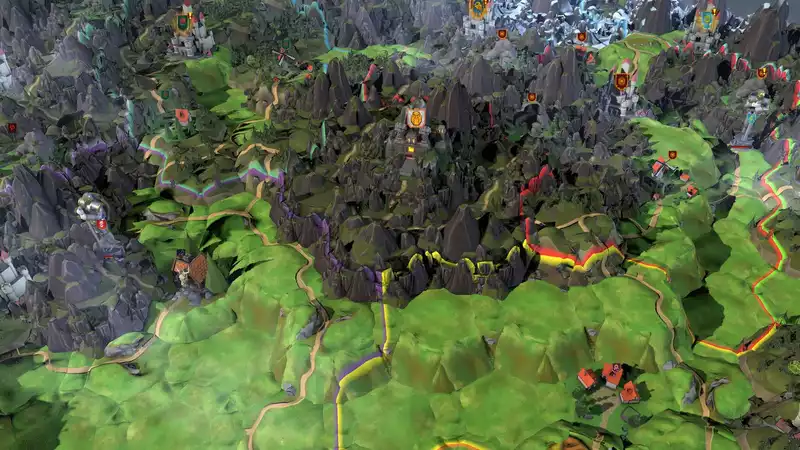The great hall is almost done, but there is a problem. I need four pieces of mortar to finish it. The mortar is made with lime at the foundry. The mortar is made with lime at the foundry. The bone ash, of course, is ground from the bones of dead enemies on the cave farm. The frustrating thing is that they have the bones to make the lime to make the mortar, but for some reason no one will carry them. No, actually, what is /really/ frustrating is that I seem to have lost my way in this cave and got lost in a 90's adventure game.
The logic of obtaining items is shared with "Gabriel Knight 3," but "Hammerting" is a game about dwarves living in mountain caves. It is also a game about arming allies in the overworld and creating impossibly complex supply chains to facilitate conquests against a common enemy. It is worth playing the tutorial.
Dwarf Fortress is hard not to mention here, but this one is not as imposing and esoteric. The vertical ant farm perspective and cheerfully drawn mountain dwellers betray the level of complexity beneath, but those who don't like starting campaigns over and over might want to sit back for this one.
The first stewardship of Moch Naxrig, a sturdy society built in a tunnel in the middle of a vast mountainside, ended when all but one of my dwarves lost consciousness from hunger. At that point, it was too late to find food sources, build a kitchen, or trade it for anything edible.
The second time I suffered the humiliation of resuming my campaign was about two hours later.
This time, well, it was starvation, but it also absolutely ruined the economy. I had spent all my money on new jobs, had nothing in my coffers, and could do nothing but sit and wait while ten dwarves took their sweet, sweet time building a dwelling for themselves. I needed to strengthen diplomatic relations and trade supplies to win the war against the enemy. Then they began to lose consciousness from hunger. Again. Food or no food, I began again, with little understanding of why all the employees seemed to be on hunger strike.
Eventually it became clear. Not only did I need to put new rooms in place and create new items, but I also needed a smooth logistical network. My unfortunate workers starved not because there was no food in the mountains, but because they did not have easy access to food.
Later in the game, as mountain lore and trading lore accumulates through exploration and trading in the overworld, railroads and elevators become available in the technology tree. There is a difference between a handful of squat cave dwellers crossing the width of the map on foot to eat a fish that someone has left by the pier, and that fish being brought in by wagon over the railroad network. It's the difference between starvation and survival.
This game is as much a city builder as it is a straight management game or 4X. It is as much a game of well-designed infrastructure as it is of new ingot types and diplomacy levels. And it is that blend of ideas and genre staples that gives Hammerting true longevity, enough to withstand several restarts and an almost incessant state of bewilderment.
Fundamentally, there is something about forcing the chaos of that mountainside cube into a work of order and efficiency. Hammerting's RPG-like elements come into play here: slay the slimes and skeletons that lurk just below the tilled tunnels and discover the caves. The dwarves you send out to explore have their own equipment slots, clan affiliations, skills, and personalities. But at least enough to invest in their well-being.
It's curious that the only real win condition is the acquisition of civ-like territory or the establishment of solid alliances, because 90% of your attention is spent on the mountainside, not on the overworld with its territorial boundaries and alliances. Once you realize that everything you are doing in the cave is just to provide your people with goods that might help them win battles or curry favor, you will eventually wonder if it was worth it to build a clinic, a tailor shop, or a complex network of scaffolding and stairs. Many of the rooms and resources of the hamarting, such as the aforementioned great hall and the hamarting itself in the title, seem superfluous in light of its true purpose.
This is probably to the game's credit. The game allows you to play it the way you want to play it, and to that end you are trying to make the most of your base and cultivate a comfortable place for the populace. But what is superfluous and what is not becomes clear only when you get to the end of the game. And at that point, or even before, you realize how much you have been fighting the same AI tendencies and mechanisms as your actual enemies.
Since the game is about long supply chains and careful resource management, it is a real problem when AI farmers do not save one item to replant their crops. It is so easy to deplete food sources this way that one wonders why everyone is starving. Equally troubling is the dwarves' lack of self-preservation, prioritizing making quills instead of eating and sleeping, or taking granite dust to a building site that they ordered 20 minutes ago. There is a job broker screen, but it can only tinker with who does certain activity types, not individual micromanagement tasks that are ignored for long periods of time.
There are things to do in the mountains, both for Warpzone Studios and for myself, and while Hammerting lacks the sophistication to grease the wheels of its impressive management hybrid, that does not mean it should be avoided. Like its overworld neighbors, new and unusual is better than the same old stock.
.

Comments